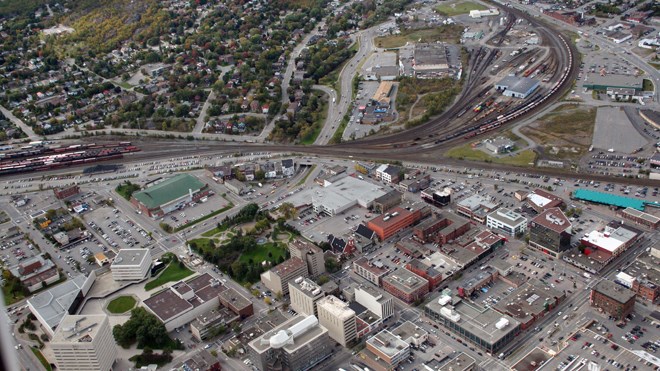City council has big plans for downtown Sudbury. But in all these promises of new glass and steel edifices, a key component is missing: a downtown is more than the buildings.
We, as a city, must take a holistic approach to the socio-economic health of the downtown core and that must take into account the non-voting, but most vulnerable members of our community.
When politicians, city planners and developers talk about urban renewal, they rarely mention basic amenities, accommodations or, dare we say it, dignity for the less fortunate.
As the hub for people, business and services, downtowns naturally draw the vulnerable members of a community because that is where the services for them most often are. Downtown is also where they can panhandle for a bit of change, purchase substances to feed their addiction and find, as hard as it might be to believe, a sense of community among their peers.
Because of recent incidents of violence in downtown Sudbury, elected officials and community leaders are suddenly paying attention to a problem they have known about for years.
The pandemic, as accurately touched on by Police Chief Paul Pedersen during this week’s Police Services Board meeting, has taken what was already a troubling situation and made it worse.
Problems tend to trickle down and the people at the bottom of society always suffer more than the people at the top.
COVID-19 forced the closure or the curtailment of many of the services the city’s vulnerable downtown population rely on to meet the basic needs of life: shelter, food, washrooms, small measures of comfort. Fewer people on the streets and fewer cars on the roads mean fewer opportunities for the small amounts of change that supply a bit of food or a place to sleep or, let us be honest, the substances that stave off withdrawal — withdrawal leads to desperation which leads to crime.
Since the pandemic broke and the lockdowns began in March, the downtown has grown grittier, dirtier and uglier. We can see the difference from the Sudbury.com newsroom, which looks out on Memorial Park. We have seen the tarp shelters and we have seen too many overdoses to count.
The signs of desperation from denizens and business owners alike are apparent: boarded up shops, smashed windows, tossed trash and recycling bins, discarded needles and syringes, people stumbling and intoxicated, people overdosing on sidewalks, in parks and alleyways, people seeking some kind of refuge where they can — much of this occurring in plain sight of city hall and the police station.
While it is a positive step that Mayor Brian Bigger has finally taken the reins and created what he called a “task team” to address the violence, crime and issues of addiction in the core, his concern is disingenuous considering he himself made it an election issue, but waited until business owners started to complain loudly enough, and one man was murdered and another stabbed before actually acting.
During the 2018 election, the mayor described the level of violence downtown as “absolutely shocking.” He said, “If we want our downtown to thrive, compete and grow, we need a downtown where seniors feel safe to go to the bank or to medical appointments. We need a downtown where parents don’t have to look over their shoulders when taking their kids to dinner or to a movie.”
He said, “I’m absolutely committed to improving the safety (and) the family friendliness of the downtown.”
Commitment is important, but we ask you, Mr. Mayor, is action not equally as important?
You promised during the campaign there would be an increased police presence downtown, even if it meant hiring more officers. There has been more police in recent months, but as Chief Pedersen pointed out this week, that is only temporary.
You promised to open a storefront in the Rainbow Centre (since rechristened Elm Place) for Greater Sudbury Police Service. In fact, the owners of the building even offered the space free of charge. That office never opened.
Back in April, a pilot project was approved to increase security around the GOVA Transit hub on Elm Street, a haven for people on the street. Approved, yes, but six months later, still not acted upon.
The city continues to approve brighter LED-powered street lights for various parts of the city. But why has downtown not been a priority for this when better lighting would offer more security for those who live and work downtown, especially during winter when people are walking to their cars or to the bus terminal in the dark?
As contentious and unpopular in some circles as they are, supervised consumption sites for people addicted to opioids are proven to help minimize precisely the types of issues our downtown faces. Yet again, they have not been a priority until recently.
This is not all on the mayor. There are four city wards that intersect downtown who have done little to push the issue among their colleagues. These are the purview of Ward 1 Coun. Mark Signoretti, Ward 4 Coun. Geoff McCausland, Ward 10 Coun. Fern Cormier and Ward 12 Coun. Joscelyne Landry-Altmann.
This is not a problem that can be solved by police alone. Enforcement must be part of a multi-faceted approach that addresses the criminal and social issues in the city core.
The challenges are complex, we realize this.
City council has said the downtown is a priority. The plans for development in the core are well-known to every Sudburian. But part and parcel of that development has to be addressing the many challenges the heart of our city faces.
The issues will not be solved overnight. There is no simple answer. But each incremental step is a step forward, and far better than standing still.
Sudbury.com’s editorial position is determined by an editorial board, consisting of senior members of the editorial team.
